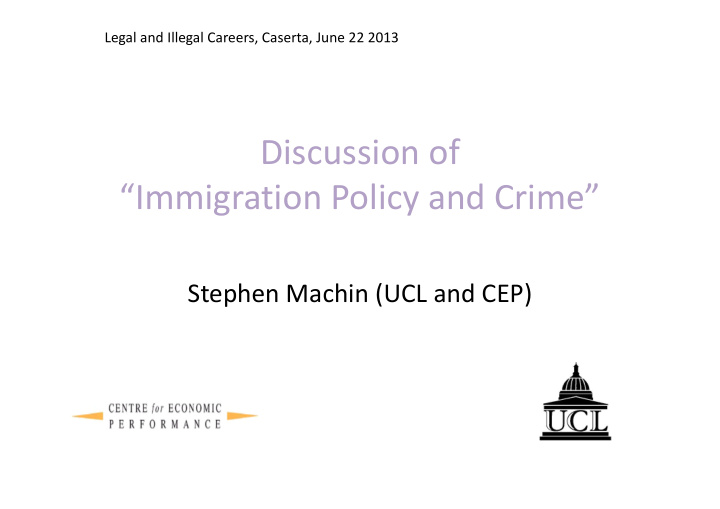



Legal and Illegal Careers, Caserta, June 22 2013 Discussion of “Immigration Policy and Crime” Stephen Machin (UCL and CEP)
Summary • Quite wide ranging study of immigration policy and crime. • Looks at the relationship between crime and immigration, with a specific eye on as to how policies on immigration affect this. • Presents a theoretical framework (in part geared up to the Italian policy context) and evidence from a range of sources, including attitudinal survey data, and various econometric results from Italy and the US. • Concludes that ‘policy does matter’ in studying the crime-immigration link.
Some Selected Findings (Chs 1, 2, 6) • Attitudinal data reveal that natives think that immigrants cause crime and that this concern is just as high as the opinions that immigrants ‘take away’ jobs from natives . [although, interestingly, there is some suggestion that once given information on the immigration numbers, this is tempered] • It proves difficult to identify any systematic empirical link between crime and immigration that implies criminals do crime more than natives, except via changes in behaviour that result from policy changes. • Patterns of crime and immigration that do go together can (in part) be traced back to the compositional differences, or selection, of observed characteristics (like education, gender, age). • The selection into legal and illegal migration matters for the crime- immigration relation.
Comments Organised into three areas: • Framework used as guide to empirical analysis. • Comments on the empirical analysis. • Directions to (possibly) go.
Framework (Ch 2) • Extension of standard economics of crime model where crime participation is shaped by economic incentives and the deterrence aspects of the criminal justice system. • Builds in illegal/legal migration status through amnesty probability, and main crime decisions are shaped by the relative utilities (where the wage in the legal and shadow economy are key determinants). • Useful as way of organising the empirical work (especially for Italy) that follows.
Framework (Ch 2) • The specific policies that are considered are directed towards amnesties and restrictions to entry. I wondered if a more general policy dimension could be built in as this would have wider applicability – for example, one dimension would be other policies nor necessarily directed at immigration per se can have effects (e.g. labour market policy, education policy). • The model has implications for selection, but less on the factors we know are important for the crime-immigration relation (notably crime is done by young men and many immigrants are young men) and that are broader than immigration studies in other areas (labour market, use of public services, etc).
Empirical Analysis (Ch 1, 6) • Immigration concerns. • Role of the criminal justice system – different stages (e.g. imprisonment differences). • Immigrant composition. • Specifics on US analysis.
Concerns Expressed About Immigrants in Attitudinal Data
Imprisonment Rates Figure 1: Foreign Population in Prison 80 70 60 50 40 30 20 10 0 % Prisoners % Population Note: % Prisoners shows the percentage of prisoners who are foreigners, while % Population shows the percentage of the population who are foreigners. If imprisonment rates were identical between foreigners and natives, the bars would be the same height within a country. Source: OECD (2007).
Immigrant Composition • The differential selection of migrants on observed characteristics matters. • In case of crime, it particularly does since many are young men and they have higher crime rates. • Example – arrests in London where broken down by nationality.
Immigrant Composition • The differential selection of migrants on observed characteristics matters. • In case of crime, it particularly does since many are young men and they have higher crime rates. • Example – arrests in London where broken down by nationality.
London Arrest Rates by Nationality Arrests/Population- Monthly Non-UK UK Diff. Arrests per 1,000 Population 3.66 2.88 0.78*** Jun-09/Jun-12 (0.04) Arrests 15-39 per 1,000 Population 15-39 5.13 5.86 -0.73*** Jun-09/Jun-12 (0.08)
US Analysis • Rather a lot of focus on the borders research – which fits in with legal versus illegal dimension, but less on crime determinants. • The analysis that does address this is the Mariel boatlift part: i) Good idea to use the quasi-experimental variation. I wondered a bit about the synthetic cohorts (weighted) control groups. Also spatially not very close. ii) Pretty sure can get more MSAs – US paper by Chalfin and McCrary sets up panel of over 200 MSAs 1960-2010 based on UCR data.
Control MSAs
(Some) Further Directions To Go • Enriched model – not in the authors’ remit, but would be very useful in this area, with reasons for migration (work, asylum, family etc) as endogenous decisions, rather than the Becker-Ehrlich generalisations. • Different effects at different stages of criminal justice systems – crime/arrest/conviction/imprisonment. Profiling? • Some evidence that enclaves seem to have lower crime rates. Community impacts on crime?
Overall Summary • Paper makes a very nice contribution. • The notion that policy matters more than inherently differential crime propensities of different migrants is an important conclusion to reach, and sits well with the still small, but growing literature on crime and immigration that emphasises migrant heterogeneities.
Recommend
More recommend